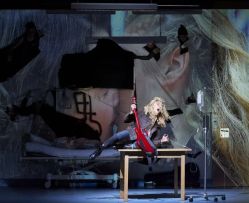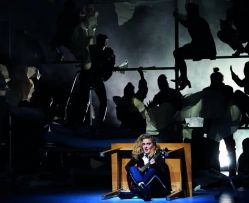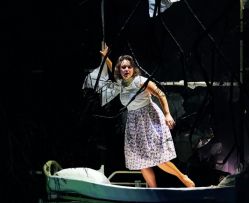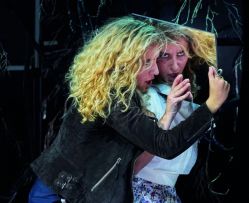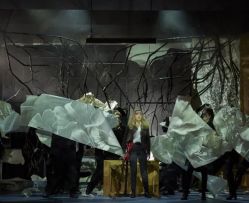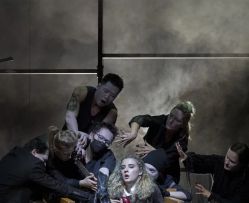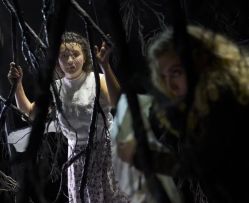Opera in three acts (1774)
Libretto by Pierre-Louis Moline und Ranieri de’ Calzabigi
Premiere:
Saturday, October 2, 2021, 7 pm
Performances:
4 / 6 / 8 / 10 / 12 / 15 / 17 / 19 / 21 October 2021, 7 pm
Introduction matinée:
Sunday, 26 September 2021 | 11 am
In French and Italian with German surtitles
New production of Theater an der Wien in der Kammeroper
Cast
Synopsis
The Apollonian singer Orpheus has lost his beloved wife Eurydice as the result of a poisonous snake bite. In a cypress grove, shepherds and nymphs join him in lamenting this untimely death and decorate Eurydice’s tomb with flowers. The winds carry Orpheus’s lamentations to the gods who have so cruelly robbed him of his beloved. Orpheus refuses to accept the fate the gods have chosen for him and intends to go into the Underworld to look for Eurydice. Amor now appears to him and announces that Jupiter, moved by Orpheus’s grief, has decided that the singer will really be allowed to descend into the Underworld. If he succeeds in appeasing the Furies and the hound of Hades with his song, Eurydice will be returned to him. However, he must not look at Eurydice before they have crossed the Styx. Neither must he reveal Jupiter’s command to her. With renewed heart, Orpheus sets off into the Underworld, accompanied by Amor’s warnings. Once there he is confronted by the Furies and the guardians who want to stop him entering Hades. But with a heart-rending song of lamentation in which he pleads for pity, Orpheus succeeds in pacifying them. He is shown the way to Elysium, the realm of the dead, where the timid spirits bring Eurydice to him. Together they negotiate the labyrinthine passages of Hades, back to the world of the living. Troubled by Orpheus’s refusal to look at her, Eurydice begins to doubt that it really is her husband whom she is following along the gloomy paths. She pressures him with questions and accusations and is starting to doubt his love for her since she cannot explain his cold behaviour and his constant urgings to hurry. Filled with fear, Eurydice feels she would rather die again and return to the tranquillity of Elysium than begin a new joyless life without love. In an agony of despair Orpheus disobeys the command of the gods and turns to Eurydice who collapses, dead, in his arms. Filled with grief, Orpheus is about to take his own life, but is prevented from doing so by Amor. Shamed by the depth of this love, Amor once again brings Eurydice back to life. Joyously reunited, the couple sing the praises of the god of love.
About the opera
Christoph Willibald Gluck and Ranieri de’ Calzabigi limited themselves (almost) to the figures of the two lovers, Orpheus and Eurydice, in their 1762 rendering of the Orpheus myth, and condensed the plot to clearly contrasting images. Instead of taking the usual labyrinthine intrigues as the basis, the authors trusted in the simplicity and clarity of the plot. By using dramatically powerful, psychologically motivated recitatives with orchestral accompaniment they avoided strict separation of secco recitatives and arias, allowing a seamless, organic transition to arioso sections. Da-capo arias, which serve merely to showcase the singers’ virtuosity, were replaced with simple but deeply moving song and chorus verses. The only concession to public taste they made was to leave the conventional “lieto fine” – the happy ending – intact, in contrast to Ovid’s version. There can be no doubt that Gluck’s first reformed opera marks a watershed in the history of opera, since it breaks radically with the norms that Metastasio had stipulated for Italian opera seria and had since become staid convention. However, this break with convention by no means came from nowhere. As early as 1754, eight years before the Vienna premiere of Gluck’s first, Italian version, Orfeo ed Euridice in 1762, the art historian Francesco Algarotti had published a slim volume in which he mercilessly attacked the theatrical conventions of his time and put forward ideas for a reform of the artistic genre of opera. The booklet prompted efforts to thoroughly overhaul opera seria that took place not only in Vienna, but at the same time in Parma, Stuttgart, Mannheim and St. Petersburg. It seems hardly surprising that Gluck’s Orfeo ed Euridice was not a resounding success in Vienna; the new opera was too unconventional, too revolutionary, for the audience. It was to be another twelve years before this success arrived, with a new, slightly amended French version in Paris in 1774, but this too was hardly surprising because in it Gluck and his French librettist Pierre-Louis Moline draw on the tradition of tragédie lyrique.





